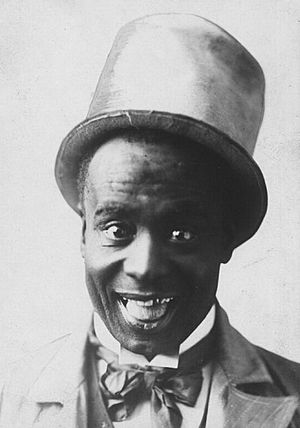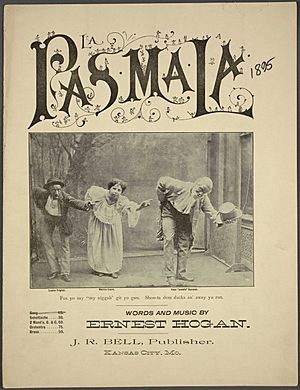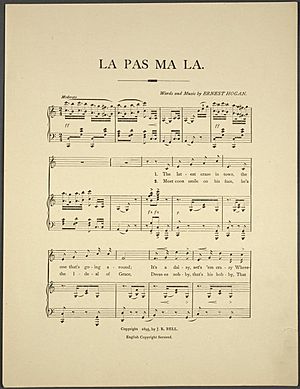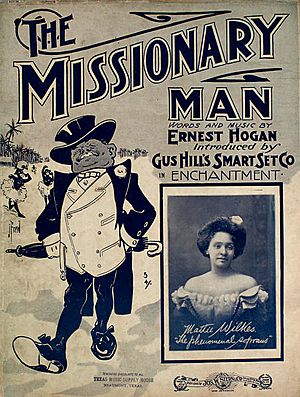Ernest Hogan facts for kids
Ernest Hogan (born Ernest Reuben Crowdus; 1865 – May 20, 1909) was a talented African-American entertainer. He was the first African-American to create and star in a show on Broadway, a famous theater district. This show was called The Oyster Man in 1907. Ernest Hogan also played a big part in making ragtime music popular.
He grew up in Bowling Green, Kentucky. As a teenager, he performed in traveling minstrel shows. He was a dancer, musician, and comedian. In 1895, Hogan wrote popular songs like "La Pas Ma La" and "All Coons Look Alike to Me." The second song became very successful. However, it also led to many similar songs called "coon songs." These songs used hurtful and stereotypical images of black people.
Ernest Hogan was known as one of the best performers and comedians of his time. But the "coon song" craze he helped start stayed with him. Before he died, he said he was very sorry for using the hurtful word in his song.
Early Life and Performances
Ernest Reuben Crowdus was born in 1865 in Bowling Green, Kentucky. We don't know much about his early childhood. But as a teenager, he joined a traveling minstrel group called the Georgia Graduates. He danced, played music, and told jokes. During this time, he changed his name to Hogan. He said he did this because Irish performers were very popular then. He also said he wanted to honor a judge named Hogan from Bowling Green. His mother had worked as a cook for this judge.
A few years later, Ernest Hogan started performing alone in New York City. He became very successful. It's likely that Hogan sometimes performed in blackface during this time, which was common then.
Creating New Music and Dance
During his career, Hogan created a funny dance called the "La Pas Ma La." It involved walking forward and then taking three steps back. In 1895, he wrote a song based on this dance. The song's chorus went:
- Hand upon yo' head, let your mind roll back,
- Back, back back and look at the stars
- Stand up rightly, dance it brightly
- That's the Pas Ma La.
After this song, Hogan released "All Coons Look Alike to Me." This song sold over a million copies.
However, many African Americans were very upset by Hogan's use of a hurtful racial slur in the song. Some black performers even changed the word "coons" to "boys" when they sang it. Also, the song's success led to many similar songs. These were called "coon songs" and used very racist and stereotypical images of black people. Later in his life, Hogan felt deep shame and regret for this song. He felt like he had betrayed his own race.
Despite the controversy, Hogan is important as one of the first creators of ragtime music. Ragtime is often called the first truly American musical genre. Hogan's songs were among the first ragtime songs ever published. They were also the first to use the word "rag" in their sheet music. Hogan never said he invented ragtime all by himself. But another black musician, Tom Fletcher, said Hogan was the "first to write down the kind of rhythm that musicians who couldn't read music were playing." In 1900, a ragtime competition was held in New York. To show their skill, semifinalists had to play Hogan's "All Coons Look Alike to Me."
Before he died, Hogan explained his feelings about the song:
That song caused a lot of trouble in and out of show business. But it was also good for show business. At that time, money was hard to find for everyone. When that song was published, it gave people a new musical rhythm. It became very popular and sold incredibly fast. That one song opened the door for many black and white songwriters. They loved the rhythm and stuck with it. Now you get hit songs without the word 'coon.' Ragtime was the rhythm played in backrooms and cafes. The ragtime players were musicians who played by ear. Their own music would have been lost if I hadn't written it down."
Later Years and Death
In January 1908, Ernest Hogan collapsed on stage in New York. He collapsed again in Boston while performing in "The Oyster Man." He had to leave the show. Hogan spent the rest of his life trying to get better, but he couldn't. He died from tuberculosis in Lakewood, New Jersey, on May 20, 1909.
See also
- African-American music
- African-American musical theater
- Coon song
- Ragtime






